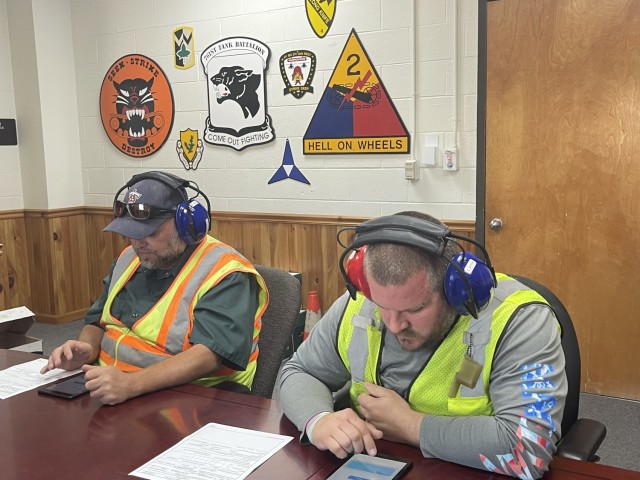
FORT CAVAZOS, Texas — Hearing health is a critical aspect for overall well-being, impacting both personal and professional lives. For the warfighter, good hearing is essential for mission readiness, while for civilian employees, it plays a crucial role in workplace safety and communication. At Fort Cavazos, the Directorate of Public Works is taking proactive steps to ensure its workforce receives the best hearing protection available, setting an example for other directorates to follow.
Maj. Theresa Galan, Fort Cavazos Hearing Program manager, Carl R. Darnall Army Medical Center, explained how hearing loss is linked to a range of health concerns, including depression, social isolation and decreased quality of life.
“When we focus on hearing conservation and hearing loss prevention, we’re looking at it from a holistic health care and quality of life aspect,” Galan said. “From the perspective of mission readiness, our warfighters need to be able to shoot, move and communicate to accomplish their mission — good hearing is a force multiplier that enhances the lethality and survivability of our warfighters.”
Galan added hearing is just as essential for the civilian workforce.
“DPW employees play a vital role in supporting the warfighter and military operations by maintaining facilities, infrastructure and training environments,” she said. “Their ability to communicate and remain aware of their surroundings is crucial to workplace safety.”
DPW has been a key partner in implementing the Department of Defense’s new requirement for hearing protector fit testing, or HPFT, ensuring employees receive the best protection possible.
“Cohesive relationships and fluid communication between the DPW, Industrial Hygiene and Occupational Health has allowed us to better care for our DPW family,” said TC Coffman, DPW Safety program manager. “Our latest partnership with Major Galan and the Hearing Conservation Program is another example of the director of Public Works, Mr. (Brian) Dosa, taking advantage of every possible opportunity to care for our team.”
The foundation for the safety and care of DPW personnel begins with a deliberate job hazard analysis, or JHA, to identify the occupational hazards, including excessive noise levels, specific tasks and processes for a position.
“The JHA is an absolute necessity when, not only identifying work-related hazards, but also in the development of the controls required to protect the employee,” Coffman said. “Mr. Dosa preaches the importance of JHAs and mandates their development and annual review with every employee.”
Coffman shared how Industrial Hygiene assists in hazard identification, evaluates processes and equipment, conducts field surveys and helps develop appropriate controls. Their reports confirm the presence of workplace hazards and assess the level of risk to employees.
Occupational Health also plays a critical role by ensuring employees exposed to hazards receive regular medical surveillance. Monitoring DPW personnel’s health over time helps detect early signs of work-related health issues, an essential practice not just beneficial but legally required.
By leveraging opportunities to enhance workplace safety, DPW embraced the concept of HPFT as a tool to educate employees on proper use of hearing protection and to ensure they receive the appropriate amount of noise reduction in their work environment.
Through the coordinated efforts of Coffman and Galan, over 95% of the DPW Operations and Maintenance Division completed hearing health education and HPFT.
“Without the support and coordination efforts of Mr. Coffman, implementing HPFT would not have been successful on a large scale for our Fort Cavazos civilian employees,” Galan said.
“Hearing protection should be a priority both at work and at home,” Galan added. “One of the easiest ways to assess noise exposure is by using the three-foot rule. If you have to raise your voice to be heard by someone standing three feet away, the noise level is likely 85 decibels and considered hazardous noise.”
Even when exposed to such environments at home, like woodworking or mowing the lawn, individuals should wear appropriate hearing protection, such as earplugs or earmuffs.
“Hazardous noise exposures over time will damage the inner ear … it is often gradual, painless and permanent, making prevention critical,” Galan said.
By promoting consistent use of hearing protection, raising awareness and leveraging HPFT, DPW further demonstrates its commitment to safeguarding its workforce, while aligning with the capability objectives of the Army Safety and Occupational Health Management System — conducting safety and occupational health training and promoting and employee health protection and readiness.

Social Sharing